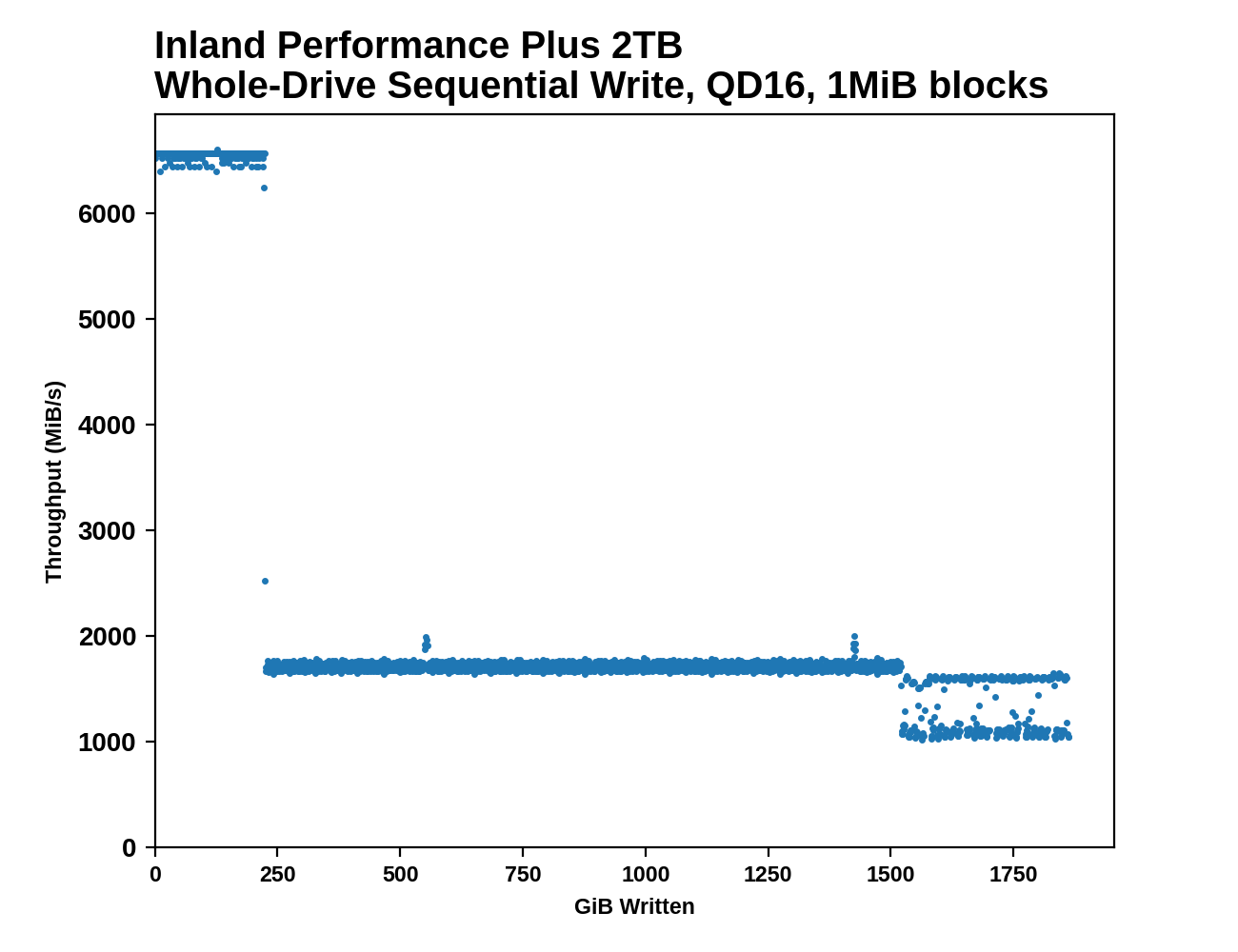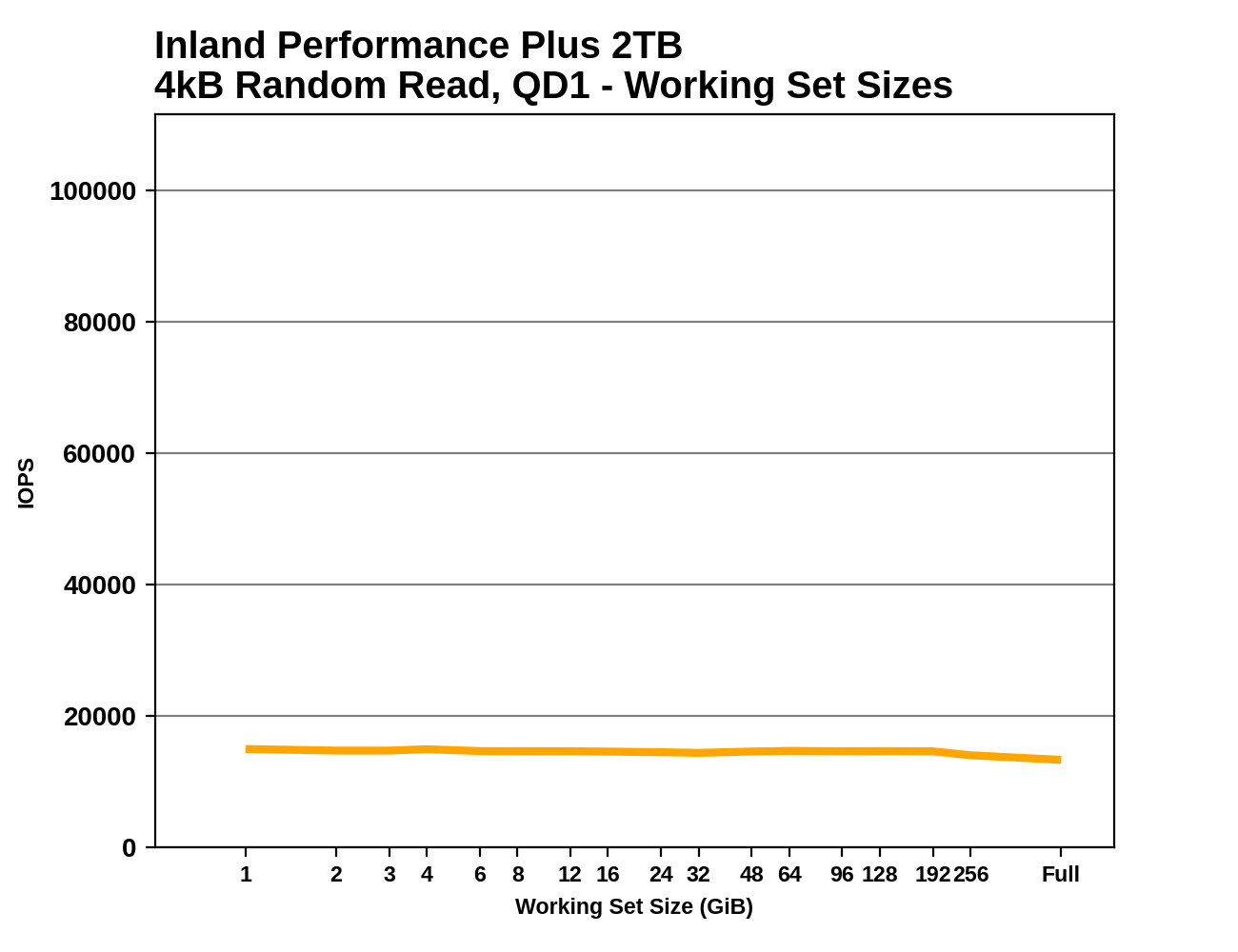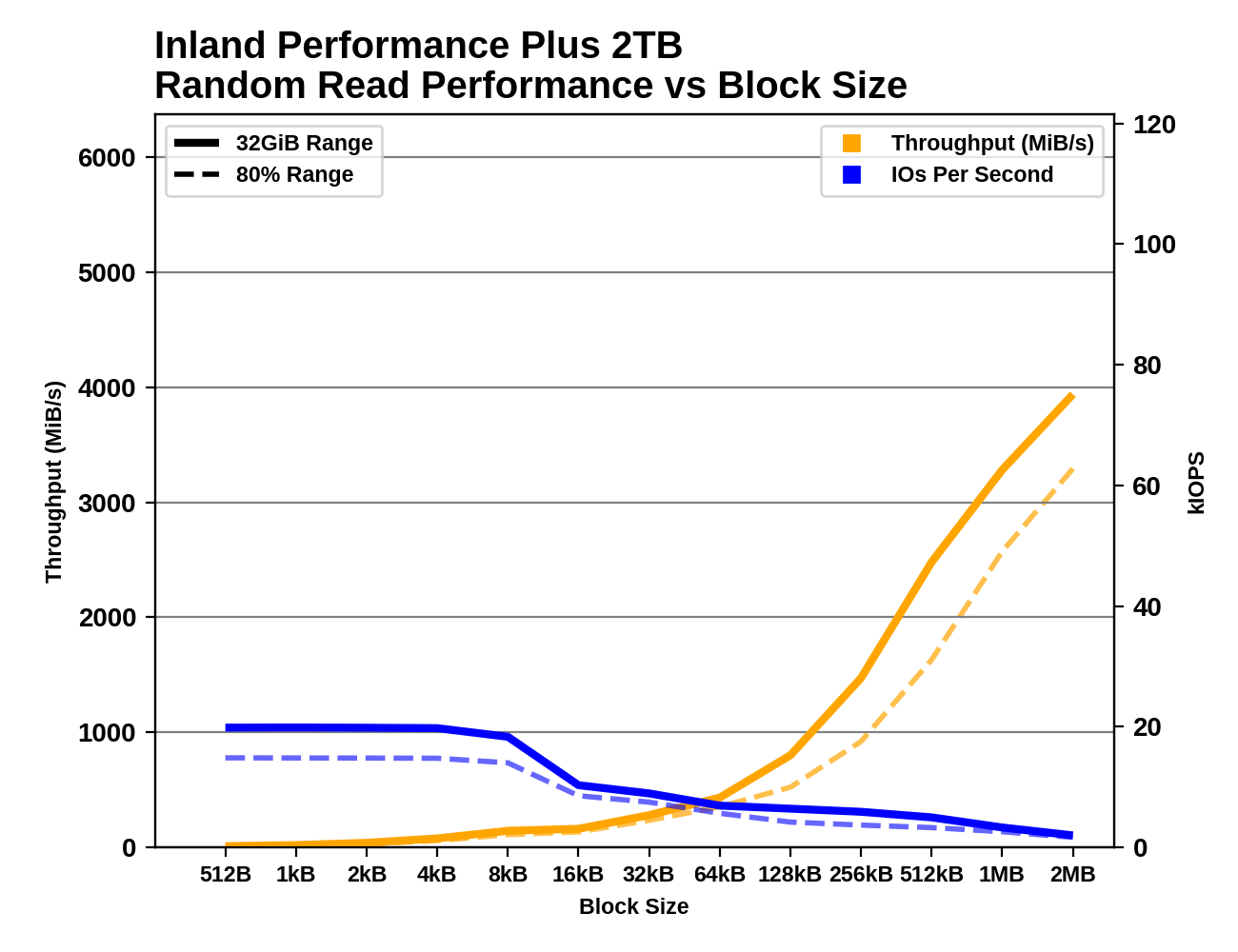The Inland Performance Plus 2TB SSD Review: Phison's E18 NVMe Controller Tested
by Billy Tallis on May 13, 2021 8:00 AM ESTAdvanced Synthetic Tests
Our benchmark suite includes a variety of tests that are less about replicating any real-world IO patterns, and more about exposing the inner workings of a drive with narrowly-focused tests. Many of these tests will show exaggerated differences between drives, and for the most part that should not be taken as a sign that one drive will be drastically faster for real-world usage. These tests are about satisfying curiosity, and are not good measures of overall drive performance. For more details, please see the overview of our 2021 Consumer SSD Benchmark Suite.
Whole-Drive Fill
 |
|||||||||
| Pass 1 | |||||||||
| Pass 2 | |||||||||
The SLC write cache on the 2TB Inland Performance Plus lasts for about 225GB on first pass (about the same cache size as 980 PRO, but a bit faster), and about 55GB on the second pass when the drive is already full. Performance during each phase of filling the drive is quite consistent, with the only significant variability showing up after the drive is 80% full. Sequential write performance during the SLC cache phase is higher than any other drive we've tested to date.
 |
|||||||||
| Average Throughput for last 16 GB | Overall Average Throughput | ||||||||
The post-cache performance is a bit slower than the fastest TLC drives, but overall average throughput is comparable to other top TLC drives. The Inland Performance Plus is still significantly slower than the MLC and Optane drives that didn't need a caching layer, but one or two more generational improvements in NAND performance may be enough to overcome that difference.
Working Set Size
 |
|||||||||
As expected from a high-end drive with a full-sized DRAM buffer, the random read latency from the Inland Performance Plus is nearly constant regardless of the working set size. There's a slight drop in performance when random reads are covering the entire range of the drive, but it's smaller than the drop we see from drives that skimp on DRAM.
Performance vs Block Size
 |
|||||||||
| Random Read | |||||||||
| Random Write | |||||||||
| Sequential Read | |||||||||
| Sequential Write | |||||||||
There are no big surprises from testing the Inland Performance Plus with varying block sizes. The Phison E18 controller has no problem handling block sizes smaller than 4kB. The random write results are a little rough especially when testing the drive at 80% full, but it's hardly the only drive to have SLC cache troubles here. Like many other drives, the sequential read performance doesn't scale smoothly with the larger block sizes, and the drive really needs a larger queue depth or very large block size to deliver great sequential read performance.










118 Comments
View All Comments
teldar - Thursday, May 13, 2021 - link
This seems ridiculous? OS queries are typically non sequential. This limits performance of everything. It's not like it's unknown that the next real step should be combined storage and ram, something that optane was supposed to do.Billy Tallis - Friday, May 14, 2021 - link
> OS queries are typically non sequential.To quantify this a bit, when I had Windows Explorer tally up the disk usage of my photos folders, about 35% of the IOs were sequential, and just over half at QD1. That should have been operating mostly on file metadata, rather than sequentially reading the actual file contents.
Valantar - Thursday, May 13, 2021 - link
Synthetic? What? The main ATSB test suite here consists of 100% real-world application traces. Sure, there are synthetics too, but the reviews are pretty explicit in pointing out that the value of those tests are mostly academic, and rather serve to illustrate why we see the differences we do in the ATSB tests.mode_13h - Thursday, May 13, 2021 - link
Please ignore the troll.Synthetics are useful for testing manufacturer claims, exploring corner cases, boundary conditions, and the outer performance envelope.
Real-world benchmarks give users some idea of what they can expect and show how the characteristics revealed in the synthetics relate to practical user experience.
Without reviews like the ones at Anandtech, manufacturers would be trying to get away with a lot more sketchy stuff, I fear, and making even more outlandish claims.
jabber - Thursday, May 13, 2021 - link
I have to say the upgrade from SSD to NVMe was one of the biggest disappointments in my computing life. There is a law of diminishing returns in day to day performance once you reach and go past 500MBps.mode_13h - Thursday, May 13, 2021 - link
Do you use antivirus? On the windows PC I use for work, they hav it so bogged down with security software that I might as well be using a hard drive!On Linux, I saw a marked difference between SATA and NVMe.
Tomatotech - Friday, May 14, 2021 - link
It depends on your OS & system. On my MacBooks, I saw a large difference going from an old but adequate 2013-era 128GB SSD to a 1TB 2019 NVMe. The new NVME was literally 3x faster in every way than the SSD and it made a huge difference to the laptop. Felt like new again.Like most things in tech, it takes around a doubling in speed for the difference to be noticeable to the user.
mode_13h - Thursday, May 13, 2021 - link
> Until Microsoft unshackles Windows from the magnetic Hard disk eraPlease explain what you mean by this. Also, not all of us are using Windows.
> I suppose these reviews and their hairsplitting synthetic benchmarks get clicks.
If you feel it's not relevant to you, then please *don't* click. And spare us your whining, as well!
I'm happy to have this review. I appreciate seeing the detailed performance analysis, as well as how much light it sheds on SSDs, their inner workings, and the overall SSD industry.
FunBunny2 - Saturday, May 15, 2021 - link
"Also, not all of us are using Windows."so far as AT Management goes, yes we are. how much ink is devoted to anything else, aka linux?
Billy Tallis - Saturday, May 15, 2021 - link
All of the synthetic tests in our SSD reviews are using Linux.